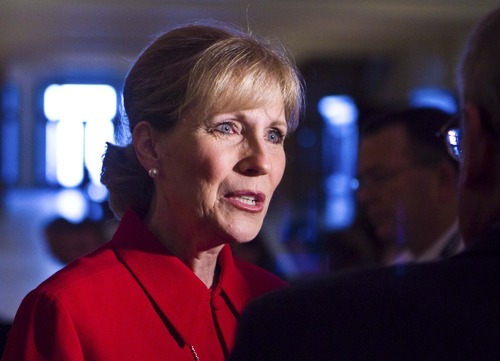This is an archived article that was published on sltrib.com in 2011, and information in the article may be outdated. It is provided only for personal research purposes and may not be reprinted.
A group calling itself "the 53 percent" is using statistics on who pays what percentage of federal income taxes to rouse opposition to the Occupy Wall Street protest movement that claims to be "the 99 percent."
Calling the protest movement "an extremely radical and extremely small fringe of the political left," FreedomWorks — a big tea party backer — posted an online petition urging people to sign their objections to the Occupy effort.
"Sign this petition to say that Occupy Wall Street DOES NOT speak for you. You are part of the 53% of Americans who pay income taxes. When Occupy Wall Street calls for more government and more spending, the 53% has to foot the bill," said the website, found at tinyurl.com/iamthe53.
So far, more than 10,000 people have signed the FreedomWorks petition. Supporters of 53 percent says the matter is an issue of personal responsibility.
—
Paying a fair share? • Bountiful resident Ronald Mortensen, co-founder of citizensfortaxfairness.org, worries that almost half of the country pays no income tax.
"Everyone has to have some skin in the game," Mortensen said. "If you have 47 percent not paying anything in, before long you have almost a majority that says 'sure, we'll raise taxes' because it doesn't impact them."
Cherilyn Eagar, a Republican candidate who aims to unseat incumbent 2nd District Democratic Rep. Jim Matheson in 2012, counts herself among the 53 percent.
"It's a matter of who's giving and who's taking," Eagar said. "I don't blame [the protesters] for being upset, but you can't punish the very people who are providing the jobs in the private sector and expect a good outcome."
Royce Van Tassell, vice president of the corporate-friendly Utah Taxpayers Association, views the frustrations expressed by the 53 percent and 99 percent groups as "flip sides to the same coin."
"The only way you can have half the population not pay income tax is if some are paying incredible amounts," Van Tassell said. "Those who are most wealthy pay a vastly disproportionate share of taxes in the country."
—
Can the poor pay more? • Some tax experts believe the data have been distorted.
The 53 percent statistic came from reports issued by the Washington D.C.-based Tax Policy Center, which is part of the Urban Institute and Brookings Institution.
Roberton Williams, a senior fellow with the center, detailed on its website why 47 percent of American pay no federal income tax.
• The earned income tax credit gives a break to low-wage earners. Also, the tax code includes credits for children, college expenses and retirement savings.
• Most who pay no federal income tax — 6-in-10 — earn less than $20,000 per year, Williams noted. But more than two-thirds who pay no income tax do pay federal payroll taxes.
"Get rid of tax preferences and tax benefits for dependents, and it's pretty much the poor and elderly who don't pay federal income or payroll taxes," Williams wrote. And even that hard-hit sector of the U.S. population pays federal excise taxes, he added.
Factor in the more regressive local and state consumption and property levies and the tax picture changes even further.
"Everyone pays taxes — it's hard to avoid. Even if you rent, the landlord passes property tax on to the renter," said Steve Wamhoff, legislative director for the nonprofit Citizens for Tax Justice, also based in Washington.
According to Wamhoff, in 2010 the richest 1 percent of American taxpayers paid 21.5 percent of the nation's total taxes and received 20.3 percent of the country's total income. The bottom 20 percent paid 2 percent of total taxes while receiving 3.5 percent of the total income.
"People think the rich pay everything and the poor and low-income pay nothing," Wamhoff said. "When you look at taxes as a whole, the system is really not that progressive."
While the federal government taxes most millionaires at higher rates, some of them pay less, Wamhoff added, referring to those who receive income from investments. About one-third of the wealthy who make $10 million or more end up with lower effective tax rates than middle-income people, he said.
—
'Superficial view' • Allison Rowland, research and budget director for the advocacy organization Voices for Utah Children, called the 53-percent perspective "a very superficial and shortsighted view of the tax code."
"Their underlying logic is that there's some kind of unfairness with some paying more taxes than others," Rowland said. "But the basic principle of a progressive tax system is that you pay more if you make more."
Some large corporations manage to avoid paying corporate income tax, Rowland added, along with some very wealthy people who decrease their payout through loopholes.
"Those are the people I would worry about," Rowland said. "Why should the system of public finance be set up to take away money from those who have the least? You can't get blood from a stone. "
Occupy SLC member Daniel Moore, 24, called the 53 percent perspective "kind of misinformed." The Utah County native works in net tech support for Unisys, but devotes his spare time to using his computer skills to advance the Occupy Wall Street movement.
"Basing it off that statistic divides the population even further," Moore said. "I'm sure that many who pay that federal income tax do not agree with them."
twitter: @catmck







